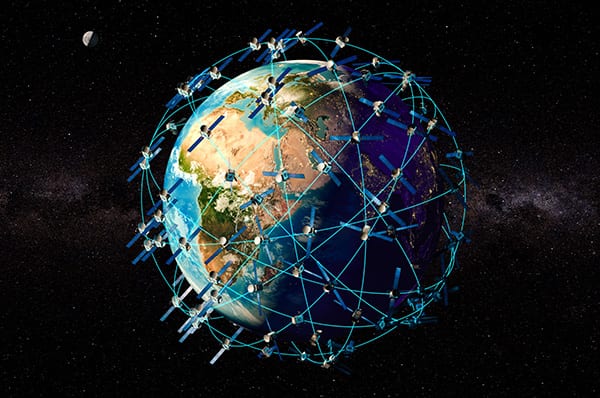Satcom Ground Engineers Target Innovations to Enable the LEO Era

Rendering of satellites around Earth. Photo: Adobe Stock via ETL Systems
Over recent years we’ve seen some impressive advancements across the satcoms industry with boundaries pushed further than we once thought possible. It was recently reported that SpaceX’s satellite broadband service Starlink, is now being tested in the United Kingdom after it was issued an Earth station network license in November. This license permits Starlink to sell satellite dishes and other communications equipment in the U.K. and means for the first time ever, people can pick up signals emitted by Starlink’s ever increasing network of satellites.
Musk’s Starlink project certainly looks set to gain impressive ground over the next few years, but it isn’t just Musk leading this charge. According to one McKinsey report, the number of satellites in orbit could exceed 50,000 over the next decade if satellite internet plans come to fruition. These innovations require cutting-edge ground segment infrastructure to effectively function. Low-Earth Orbit (LEO) satellites move across the sky at several kilometers per second — creating new opportunities, but also challenges for ground station engineers.
This highlights the task ahead for ground segment engineers if companies such as Telesat, OneWeb, Amazon and SpaceX are to achieve their ambitions. Despite what the fanfare might lead you to believe, it’s not just a small handful of big names and global tech giants behind these achievements. There are thousands of others working behind the scenes, developing vital components to ensure these projects can run as smoothly as possible.
Radio Frequency (RF) equipment, frequency converters, amplifiers, switch matrices and RF over fiber technologies are already being re-engineered, ready for manufacture at a scale we’ve never before seen in this industry. While keeping costs down is a key factor, this needs to happen without compromising on resilience, redundancy, and the extremely high quality and reliability synonymous with satcom systems.
Once launched, LEO constellations will require multiple tracking antennas, or programmable flat panel antennas, with RF connections being routed intelligently to offer redundancy, as well as ensuring that within existing teleports new antenna arrays and new Master Control Rooms (MCRs) or Network Operating Centers (NOCs) can facilitate local or remote control.
It’s also crucial that multiple LEO tracking antennas can be connected and switched via the master control system, something that engineers are taking incredibly seriously. Through the development of a new standardized range that can do more, operating over wider IF bandwidths to provide high speed, low latency services across the globe — teams are already pushing boundaries in engineering.
This is all very achievable, but what’s required is on a scale not seen before in our industry and as part of a business model only now being tested in the real world.
Ground segment engineers make up a small section of the industry developing at lightning pace, and are finding they need to adapt from designing extremely high-quality, low-quantity RF equipment, towards producing high quality and high quantity at a lower cost – while maintaining the key characteristics of reliability, resilience and dependability. This no easy task.
Whole RF distribution chassis are now becoming modular and can be re-designed and hot-swapped in and out of the chassis in a matter of minutes. With multi-function mix and match modules such as amplifier, switch, splitter, and combiners less rack units are needed. At the end of life, modules can be renewed without the need to replace entire chassis. This is also especially important where operating parts such as power supplies and fans can be easily replaced, allowing the RF system modules to remain operational.
Over the next few years we predict that this style of chassis will become even smarter, forming a habitat for remote control modules functions such as gain, switching and other auto-redundancy features — offering 24/7 operations for the new generation of satellite constellation signals that need to reach the ground.
Ultimately, the success of Starlink and other LEO constellations rests on the wider industry’s ability to remain adaptable. Engineers working on the ground segment and infrastructure must also remain poised to develop and roll-out the exciting new technologies required to make the dream of connectivity for all a reality.

Andrew Bond leads the team who deliver the Sales & Marketing for ETL Systems, an international designer and manufacturer of satellite communications equipment. Andrew joined the ETL team in 2005 to support its expansion into new global markets.